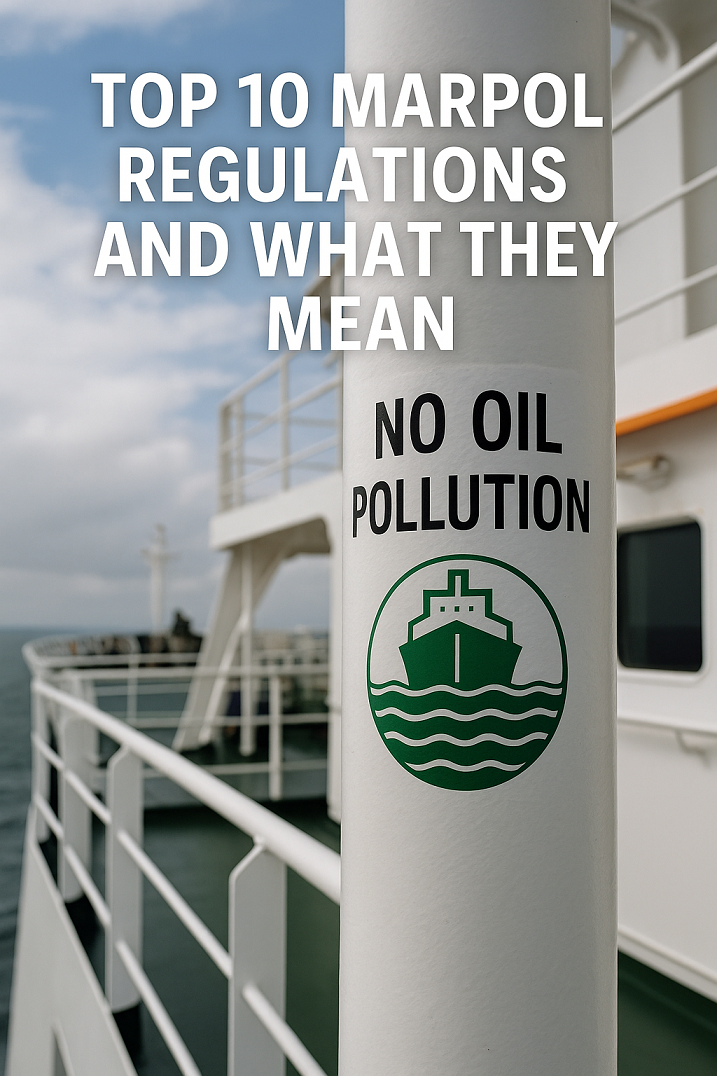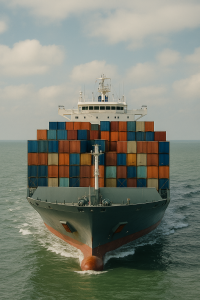Discover the top 10 MARPOL regulations that shape environmental compliance at sea. Learn how each rule impacts vessel operations and what every seafarer must know to prevent marine pollution.
Why MARPOL Regulations Matter in Modern Maritime Operations
As global trade continues to rely on maritime transport—accounting for over 80% of world trade by volume according to the International Maritime Organization (IMO)—so does the responsibility of shipping companies to minimize their environmental footprint. Enter MARPOL: the International Convention for the Prevention of Pollution from Ships.
First adopted in 1973 and strengthened through the MARPOL 1978 Protocol, the Convention is the cornerstone of maritime environmental compliance. It’s not just about legal obligation—it’s about safeguarding marine ecosystems, human health, and the global climate.
For seafarers, understanding MARPOL isn’t theoretical—it’s operational. From the engine room to the bridge, every action taken onboard can be traced to a MARPOL regulation. Knowing these rules is essential to staying compliant, avoiding hefty fines or detentions, and protecting the seas we sail.
What is MARPOL?
MARPOL (short for Marine Pollution) is a binding international treaty developed by the IMO. It contains six technical annexes, each focused on a specific type of pollution:
-
Annex I – Oil
-
Annex II – Noxious Liquid Substances
-
Annex III – Harmful Substances in Packaged Form
-
Annex IV – Sewage
-
Annex V – Garbage
-
Annex VI – Air Pollution
Ships over a certain size or tonnage are required to comply with applicable annexes, and flag states are responsible for enforcing compliance.
1. Annex I: Prevention of Pollution by Oil
This is perhaps the most critical and widely enforced regulation under MARPOL. It prohibits the discharge of oil or oily mixtures into the sea unless under strict conditions (e.g., below 15 ppm and with an operational Oily Water Separator (OWS)).
Requirements Include:
-
Oil Record Book (Part I and II for tankers)
-
Oil Discharge Monitoring Equipment (ODME)
-
Sludge tank and incinerator operations
-
Double hull requirements for tankers
Real-World Case: In 2016, a shipping company was fined over $2 million in the U.S. for bypassing the OWS and falsifying the Oil Record Book—known as a “magic pipe” case.
2. Annex II: Control of Pollution by Noxious Liquid Substances in Bulk
This Annex governs the discharge and handling of noxious liquid substances (NLS) carried in bulk, such as chemicals and hazardous materials.
Key Points:
-
Vessels must have a Cargo Record Book
-
Pre-wash and discharge procedures are mandatory
-
Substances are categorized (X, Y, Z, OS) based on hazard
Stat: According to EMSA (2023), improper tank cleaning and residue disposal remain top causes of chemical discharge incidents.
3. Annex III: Harmful Substances Carried in Packaged Form
This annex ensures that packaged harmful goods (e.g., pesticides, batteries, flammable liquids) are labeled, stowed, and transported correctly.
Requirements:
-
IMDG Code compliance
-
Proper documentation and emergency response info
-
Secure stowage plans and segregation protocols
Note: Any improperly labeled container can result in detention during Port State Control inspections.
4. Annex IV: Prevention of Pollution by Sewage
This Annex regulates the discharge of sewage into the sea, especially in proximity to land and sensitive marine environments.
Key Equipment:
-
Sewage treatment plants (certified by the flag state)
-
Holding tanks and discharge lines
-
Sewage Record Book (optional for smaller vessels)
Limitations:
-
No untreated sewage within 12 nautical miles of the nearest land
-
Special Area rules (e.g., the Baltic Sea) impose stricter controls
5. Annex V: Prevention of Pollution by Garbage from Ships
One of the most visible forms of marine pollution, Annex V targets waste disposal at sea. It classifies garbage into types—plastics, food waste, domestic waste, etc.—and restricts or bans their discharge.
Key Regulations:
-
No plastic discharge under any circumstances
-
Garbage Management Plan onboard
-
Garbage Record Book with regular entries
-
Designated Garbage Officer
Stat: A study by Ocean Conservancy found that over 8 million tons of plastic enter the ocean annually, and shipping contributes a portion through mismanaged waste.
6. Annex VI: Prevention of Air Pollution from Ships
This is one of the most dynamically evolving areas of MARPOL. Annex VI sets limits on SOx, NOx, PM, and GHG emissions, including carbon dioxide and methane.
Notable Requirements:
-
0.50% sulfur cap globally (as of January 2020)
-
0.10% sulfur limit in Emission Control Areas (ECAs)
-
NOx emission tiers for marine engines
-
Ship Energy Efficiency Management Plan (SEEMP)
-
Energy Efficiency Existing Ship Index (EEXI) and Carbon Intensity Indicator (CII) introduced in 2023
Analogy: If Annex I is the ship’s environmental firewall, Annex VI is the air purifier—ensuring cleaner skies and compliance with climate goals.
7. Discharge Standards and Operational Restrictions
Each annex outlines where, when, and how discharges can occur—or if they are prohibited outright. For example:
-
Oil: Not within 50 NM from shore
-
Garbage: Varies by type and location
-
Sewage: Not in ports or designated Special Areas
Violating these rules not only risks fines but can lead to criminal charges, particularly in jurisdictions like the U.S., which enforce MARPOL through the Act to Prevent Pollution from Ships (APPS).
8. Recordkeeping and Documentation
Documentation is the seafarer’s shield during inspection. Under MARPOL, ships must maintain accurate and up-to-date:
-
Oil Record Books
-
Cargo Record Books
-
Garbage and Sewage Logs
-
Engine Logbooks
-
Emission monitoring data (Annex VI)
Best Practice: Never backdate entries or leave logs incomplete. Consistency between records and real conditions is crucial.
9. Training and Awareness
MARPOL compliance depends on a well-trained crew. According to STCW and ISM Code standards:
-
Seafarers must undergo environmental familiarization
-
Officers should know discharge protocols and ECA entry requirements
-
Engine crew must be trained in OWS and incinerator operations
Companies often supplement IMO-mandated training with onboard drills and computer-based learning (CBT).
10. Port Reception Facilities and Waste Management
Ships must offload certain wastes at approved Port Reception Facilities (PRFs) when at port.
Examples of MARPOL Waste:
-
Oily bilge water (Annex I)
-
Residual chemicals (Annex II)
-
Plastics and food waste (Annex V)
-
Exhaust cleaning residues (Annex VI)
Ships are advised to log all waste delivery receipts and report inadequate facilities to IMO using the GISIS platform.
Real-World Application: The Cost of Non-Compliance
In 2022, a bulk carrier in the Mediterranean was fined €350,000 for illegal discharge of oil near the coast of France. Investigators used aerial surveillance and satellite imagery to track the spill back to the ship.
Not only was the crew penalized, but the company faced reputational damage, increased insurance premiums, and extra audits. This case underlines that MARPOL is enforced, and ignorance is no excuse.
FAQ: MARPOL and Shipboard Compliance
Q1: Is MARPOL mandatory for all ships?
A: Yes, MARPOL applies to almost all seagoing ships, regardless of size or flag, depending on the annex.
Q2: Can ships discharge oil at sea?
A: Only under strict conditions (e.g., treated oil below 15 ppm and outside restricted zones). Otherwise, it’s prohibited.
Q3: What is EEDI and CII in Annex VI?
A: These are energy efficiency and carbon intensity measures introduced to reduce GHG emissions from ships.
Q4: How often are MARPOL regulations updated?
A: Frequently. IMO’s Marine Environment Protection Committee (MEPC) updates and amends annexes regularly.
Q5: Who enforces MARPOL?
A: Flag states, port state control, and coastal states like the U.S. under APPS. Enforcement includes fines, detention, or prosecution.
Q6: Can crewmembers be held personally liable for MARPOL violations?
A: Yes. In some jurisdictions, chief engineers and officers have been prosecuted for falsified logbooks or bypassing equipment.
Conclusion
The top 10 MARPOL regulations aren’t just checkboxes—they are fundamental to the future of clean, compliant, and responsible shipping. Whether you’re navigating open oceans or conducting engine room operations, MARPOL shapes every decision.
Understanding these regulations enables seafarers to operate confidently, avoid violations, and contribute meaningfully to ocean conservation. Environmental compliance isn’t optional—it’s professional, personal, and planetary.
Call to Action: For MARPOL updates, regulatory news, and compliance checklists, visit our Environmental Compliance Resource Hub.
References
-
International Maritime Organization (IMO). (2023). MARPOL Convention. https://www.imo.org
-
EMSA. (2023). Annual Overview of Marine Casualties and Incidents. https://emsa.europa.eu
-
Ocean Conservancy. (2022). Plastics and Ocean Health. https://oceanconservancy.org
-
United States Environmental Protection Agency (EPA). (2023). MARPOL Enforcement and Compliance. https://www.epa.gov



I’m so happy to read this. This is the kind of manual that needs to be given and not the accidental misinformation that’s at the other blogs. Appreciate your sharing this greatest doc.